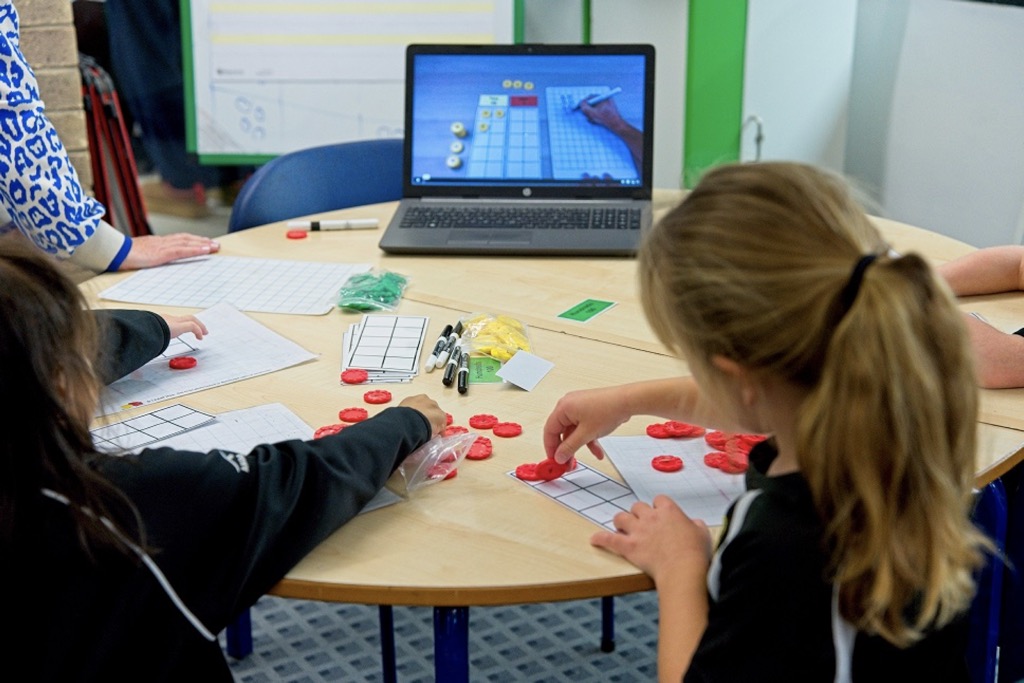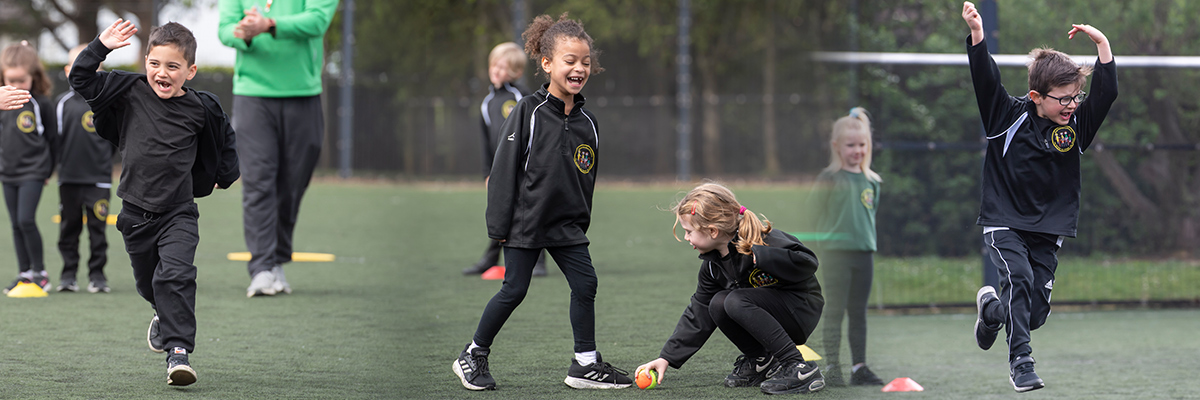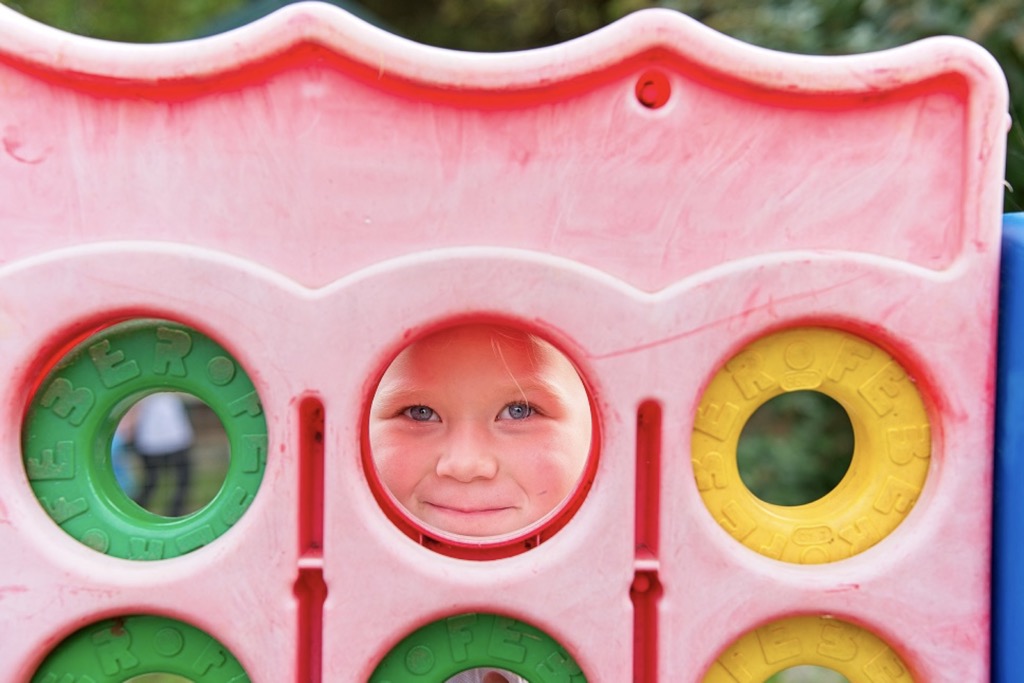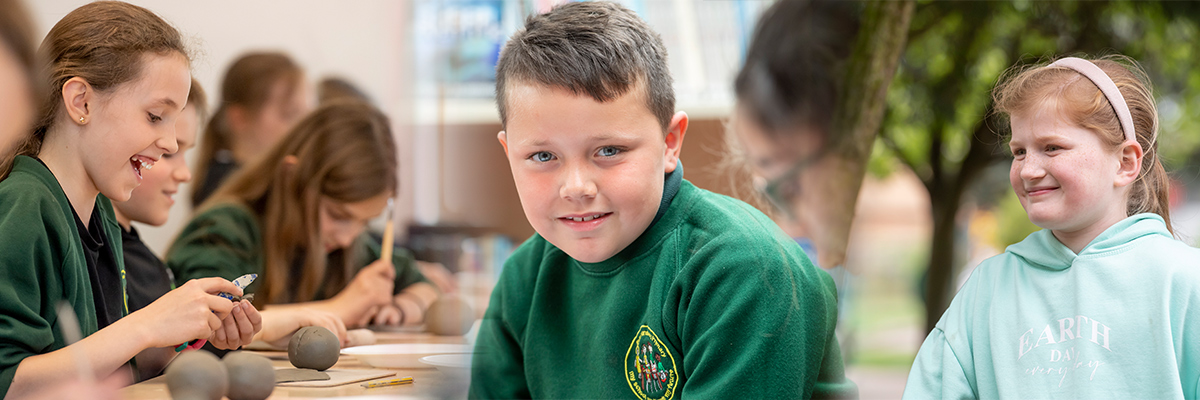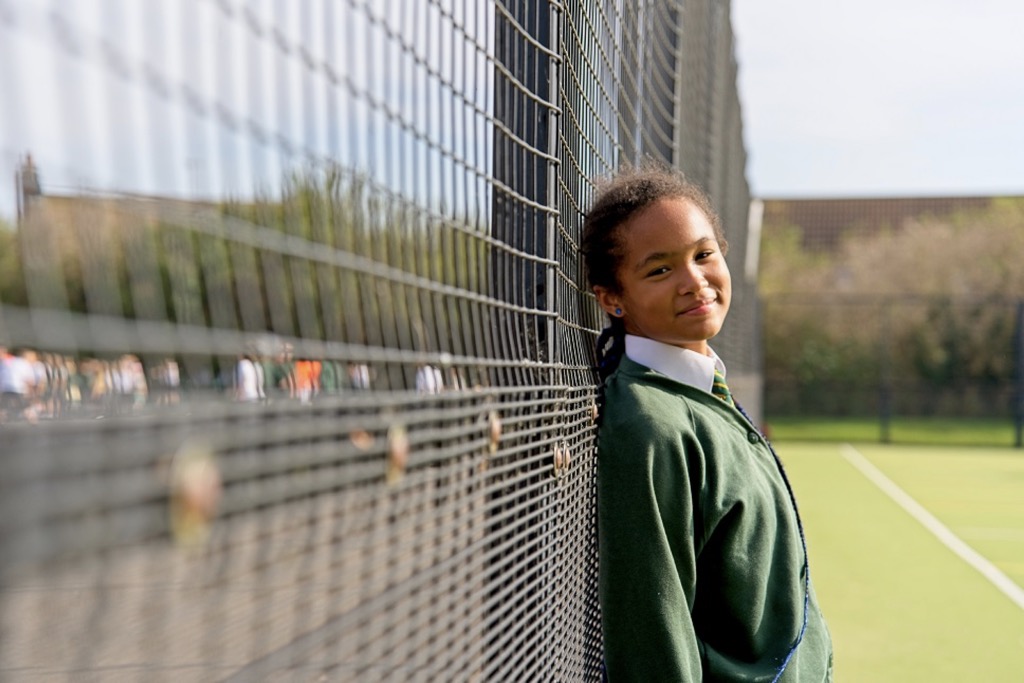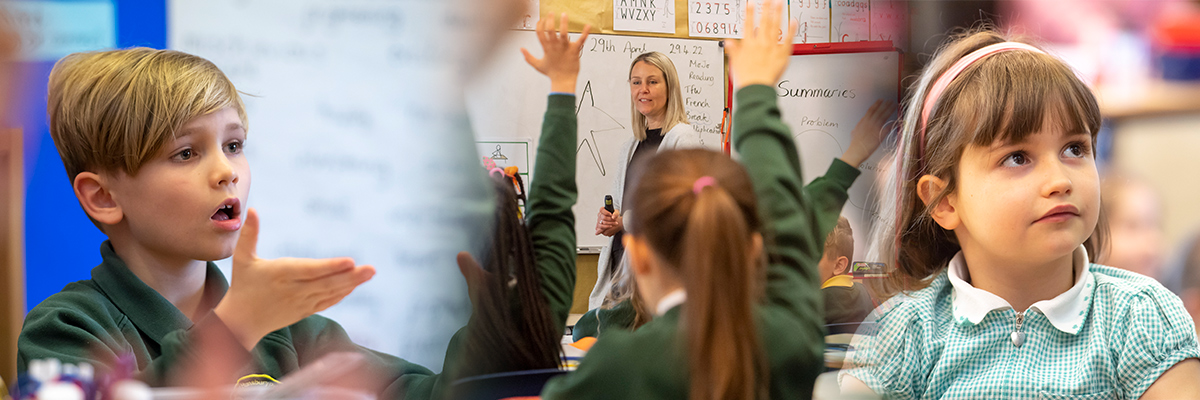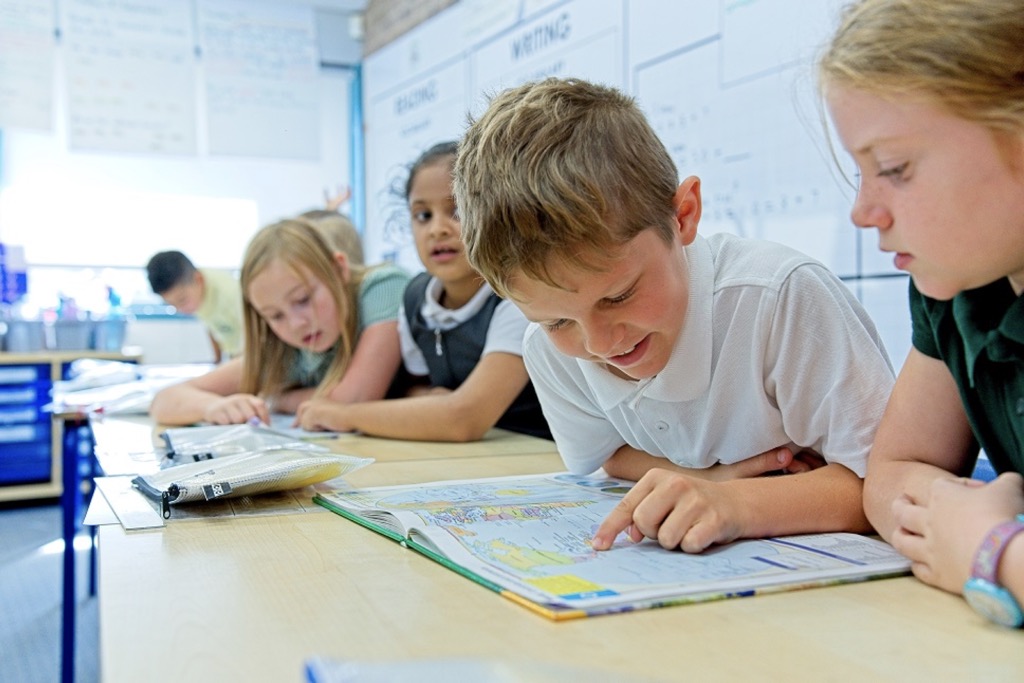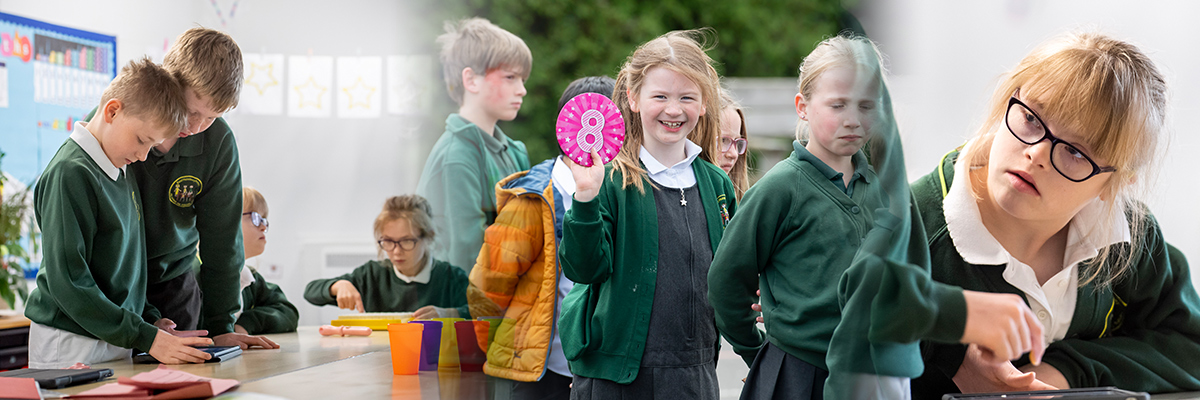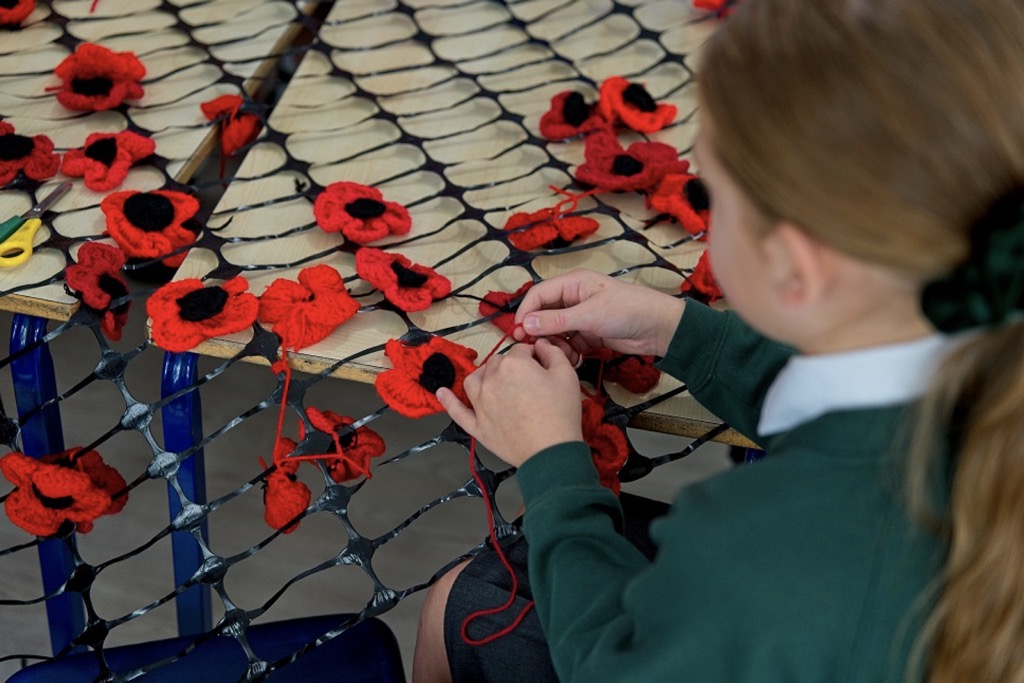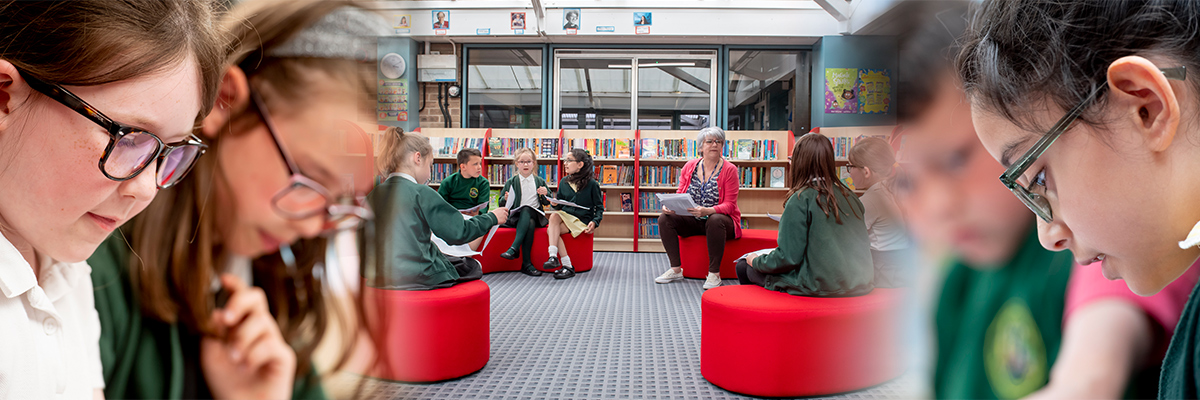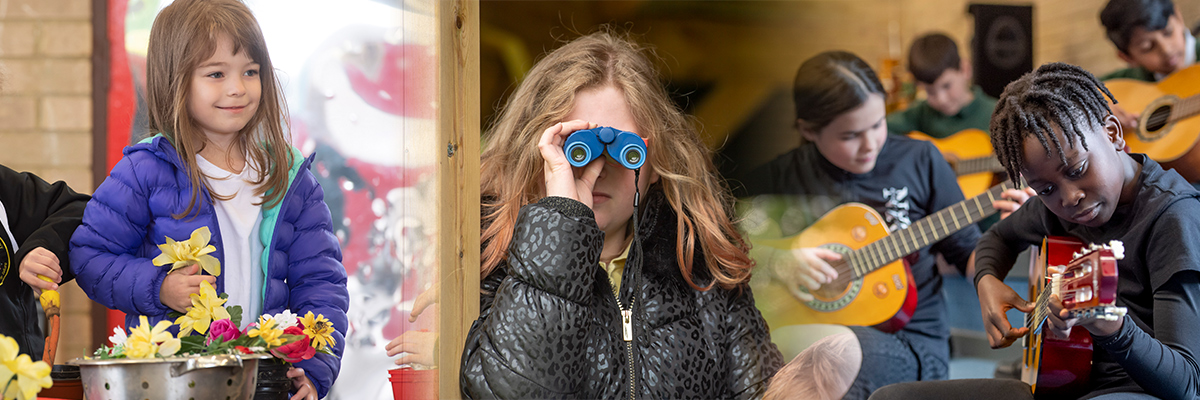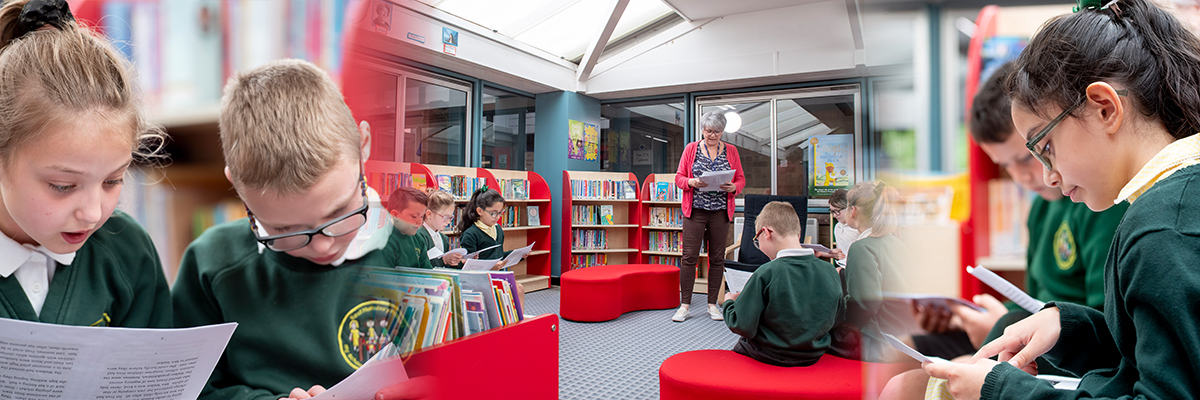Our Curriculum : Music
At East Hunsbury Primary School, it is our intention that our music curriculum is aspirational, enabling, inclusive and enriching. We intend to teach music so that our pupils enjoy and gain knowledge of how music making and music appreciation can enrich their lives. Our music curriculum is intended to:
-
Give children the opportunity to appreciate, perform, understand and compose music from a range of times, traditions, genres and composers.
-
Enable children to sing and play musically with increased confidence and control.
-
Give all children an opportunity to learn/play a musical instrument.
-
Ensure our children develop the technical vocabulary which will help them understand and appreciate music.
-
Encourage mental health and wellbeing by bringing the whole school community together through music.
Working in partnership and with our local music hub (Northampton Music and Performing Arts Trust) we intend to create a strong musical culture within our school. Music has the power to foster connections within the brain which will improve memory and coordination. The skills involved in playing and listening to music will also help learners develop the self-esteem, self-discipline, cooperation, creativity, and self-motivation necessary for success. We aim to establish a lifelong passion for music as an art form is that it is accessible to all. It is an art form that is entwined into the fabric of our lives and we aim to enable children to enrich their experience of all types of music.
We want children continue to grow in confidence as they progress through the music curriculum and become passionate in their responses to music alongside becoming more independent learners, reflecting upon their learning and developing resilience within the musical world.
Music lessons are taught by our specialist music teacher, ensuring all pupils have access to high quality teaching led by a confident and passionate practitioner and enabling them to access a wide range of music from across all genres and time periods.
Our music curriculum has been intentionally designed to ensure children develop substantive knowledge alongside disciplinary knowledge as they learn the fundamental elements of what it is to be a musician. Our music curriculum engages, inspires and challenges children, equipping them with the knowledge and skills to experiment, invent and create their own improvisations and compositions, and have the confidence to perform them as they learn how to be a musician. Children develop their knowledge of the music theory that underpins practical work and they appreciate, evaluate and engage critically with a wide variety of music, listening with concentration and detail and expressing their preferences.
The following high dividend concepts have been identified as part of our music curriculum: pitch, duration, tempo, dynamics, timbre, texture, structure and notation. These form the ‘Big Ideas’ through which performance, improvisation and composition are taught. Children refer to these concepts when listening to and appraising music from across the musical canon.
The impact of our music curriculum is measured through a multi-faceted approach including:
- Pupil voice for the monitoring of music provision and for pupils to express their opinions and preferences regarding music lessons and activities.
- Singing snapshot assessments completed termly (year 1-6)
- Termly assessments based on the Model Music Curriculum Minimum Expected Standards (Years 1-6).
- Observations of pupil performances, including singing and school productions.
- Evaluating compositions.
- Achieving awards and quality marks such as Music Mark (which we have achieved for the past 3 academic years).
Our specialist music teacher undertakes assessments during lessons and liaises closely with class teachers on pupil performance, outcomes and attainment. A flexible three-tier termly assessment tool, based on the Model Music Curriculum Minimum Expected Standards, is used to track progress and provide information for Parents’ Evenings and Annual Reports. Furthermore, children’s singing is assessed following the ‘Sing Up’ progression singing snapshots which involves one song for each year group being introduced in Term 1 which is then revisited and developed in Terms 2 and 3. These provide an opportunity for gathering evidence of how the children are achieving in line with their year group outcomes over time.
We use NMPAT’s music curriculum (based on The Model Music Curriculum) which is carefully sequenced and has a clear progression of substantive and disciplinary knowledge over time. The curriculum has been written by specialists, encompasses our ethos for high quality music teaching and has clear, defined end points.
The units taught include:
- Singing, playing and performing
- Learning to play a range of instruments
- Listening, appraising and musicianship
- Learning ways to show musical notation
- Reading musical notation
- Improvising and creating their own compositions
- Using music technology (KS2)
|
Long Term Plan – Curriculum music |
||||||
|
Unit 1 - Autumn 1 |
Unit 2 – Autumn 2 |
Unit 3 – Spring 1 |
Unit 4 – Spring 2 |
Unit 5 – Summer 1 |
Unit 6 – Summer 2 |
|
|
EYFS |
Title: Favourite Things /Autumn Main skill focus: Sing and Play, Listening Musical focus: Exploring sounds, pitch (soh-me interval) Resources: Inside Music Early Years (Voices Foundation) Jolly Music Unit Summary: Explore the different sounds made by the voice, hands, found objects and percussion instruments (timbre) |
Title: Halloween/ Light/Winter Festivals/ Story Settings Main skill focus: Sing and Play Listen and Appraise Musical focus: Pitch (higher/ lower), dynamics (louder/quieter), musical storytelling Resources: Inside Music Early Years (Voices Foundation) Sing Up: Sorcerer’s Apprentice Unit Unit Summary: Explore higher and lower sounds (pitch) and louder and quieter sounds (dynamics) |
Title: Cold/Winter/ Main skill focus: Sing and Play, Listen and Appraise Musical focus: Pulse (slower/faster) Resources: Inside Music Early Years (Voices Foundation) Jolly Music Unit Summary: Exploring faster and slower sounds (tempo) (pulse)
|
Title: Earth/The Woods Main skill focus: Sing and Play, Listen and Appraise Musical focus: Duration, (longer/shorter) Resources: Inside Music Early Years (Voices Foundation) Jolly Music, Sing Up: Bird Spotting Unit Unit Summary: Exploring longer and shorter sounds (duration) (rhythm)
|
Title: Growing Main skill focus: Sing and Play, Listen and Appraise Musical focus: Exploring sound and meaning Resources: Voices ‘Early Years 0-5, Jolly Music, NYCOS Singing Games for Early Years, Voice links Unit Summary: Exploring Sounds and Meaning
|
Title: Minibeasts/Sea Main skill focus: Sing and Play, Listen and Appraise, Improvise and Compose Musical focus: Pitch (higher/ lower), Pulse (faster/slower), Dynamics (louder/quieter) Resources: Inside Music Early Years (VF), Jolly Music, Sing Up – 5 Fine Bumblebees & Down Under the Sea Unit Summary: Re-visiting the 3 Comparatives: Higher/Lower, Faster/Slower, Louder/Quieter |
|
Year 1 |
Title: The King is in the Castle and Storytime Main skill focus: Sing and Play, Listen and Appraise Musical focus: Structure, timbre, pitch, dynamics, exploring sounds Resources: Sing up and Music Express Unit Summaries: ‘The King is in the Castle’ is based around a song about the people/mythical characters who might inhabit a castle. Children will explore vocal and instrumental timbre, structure and rhyme, dynamics, and pitch. ‘Storytime’ explores how music can be used in a story. |
Title: Number and Menu Song (incl. Singing Snapshot 1) Main skill focus: Sing and Play, Improvise and Compose Musical focus: Active listening (movement), beat, singing progression snapshot 1 (echo singing, showing pitch movement) Resources: Music Express and Sing Up Unit Summaries: ‘Number’ helps children develop a sense of beat and ‘Menu Song’ is a fun, cumulative song and the children will create a group performance using kitchen themed props. |
Title: Animals and Our Bodies Main skill focus: Sing and Play, Listen and Appraise Musical focus: Pitch, beat Resources: Music Express Unit Summaries: ‘Animals’ develops children’s understanding of pitch using movement, voices and instruments. ‘Our Bodies’ develops the children’s rhythm/sense of beat. |
Title: Football (incl. Singing Snapshot 2) Main skill focus: Sing and Play, Compose Musical focus: Beat, ostinato, pitched/unpitched patterns, mi-re-do (notes E-D-C), singing progression snapshot 2 (call and response) Resources: Sing Up Unit Summary: ‘Football’ is a lively, rhythmic chant about football. This unit sees children echo singing, composing word patterns, improvising with mi-re-do, and playing a percussion ostinato. |
Title: Water and Musical Conversations Main skill focus: Sing and Play. Listen and Appraise Musical focus: Pitch, question and answer, timbre, graphic score Resources: Music Express and Sing Up Unit Summaries: ‘Water’ uses voices, movement and instruments to explore changes of pitch. ‘Musical Conversations’ describes how to create musical conversations and children will invent and compose short pieces based around question-and-answer interactions. |
Title: Bringing stories to life with music (incl. Singing Snapshot 3) Main skill focus: Improvise and Compose Musical focus: Performance skills. beat, pitch, composing, singing progression snapshot 3 (echo singing) Resources: Unit by Sue Nicholls and Sing Up Unit Summary: ‘Bringing Stories to Life’ develops children’s ability to listen to and compose music to a familiar story. |
|
Year 2 |
Title: Tony Chestnut (incl. Singing Snapshot 1) Main skill focus: Sing and Play, Improvise and Compose Musical focus: Beat, rhythm, melody, echo, call-and-response, tuned and untuned, singing progression snapshot 1 (copy beat actions) Resources: Kapow and Music Express Unit Summary: ‘Tony Chestnut’ is based on a song with a simple tune and clever lyrics. Children will learn to sing with good diction, play the melody of the song on tuned percussion and explore call-and-response making up call-and-response patterns with actions. their voices and with instruments.
|
Title: Storytime and Our Land Main skill focus: Improvise and Compose Listen and Appraise Musical focus: Exploring sounds, beat, rhythm, timbre, texture Resources: Music Express and Sing Up Unit Summaries: ‘Storytime’ helps the children combine sounds to create effective music which help tell a story. ‘Our Land’ focusses on instrumental music inspired by British Myths and Legends. Children will explore timbre and texture to understand how sounds can be descriptive.
|
Title: Grandma Rap (incl. Singing Snapshot 2) Main skill focus: Sing and Play, Improvise and Compose Musical focus: Duration, crotchet, quavers, crotchet rest), unison, round, Singing progression snapshot 2 (partner clapping game) Resources: Sing Up Unit Summary: ‘Grandma Rap’ explores beat and rhythm work using crotchets and quavers. Stick notation is introduced, and children go on to create their own 4-beat patterns, which they will loop creating an accompaniment to perform the rap to. |
Title: Musical Me Main skill focus: Sing and Play Musical focus: Pitch, notation, melody Resources: Kapow Unit Summary: ‘Musical Me’ focusses on children learning to sing the song ‘Once a Man fell in a well’. Children will then explore the song playing it using tuned percussion and reading simple symbols representing pitch.
|
Title: Tańczymy labada (incl Singing Snapshot 3) Main skill focus: Sing and Play, Improvise and Compose Musical focus: Singing games, traditional Polish dances, changing beat and tempo, playing a percussion accompaniment, singing progression snapshot 3 (invent body percussion sounds) Resources: Sing up Unit Summary: ‘Tańczymy labada’ is a Polish circle game which will develop children’s sense of beat and encourage cooperative play. Children will sing confidently in another language, play singing games, play an accompaniment and invent a 4-beat body percussion pattern. |
Title: Weather and Seasons Main skill focus: Listen and Appraise Musical focus: Exploring sounds, word rhythms, pitch shapes Resources: Music Express Unit Summaries: ‘Weather’ develops children’s ability to create descriptive sounds and word rhythms with raps and songs about the weather. ‘Seasons’ develops the children’s understanding of pitch through movement, songs and listening games. |
|
Year 3 |
Title: I’ve been to Harlem (incl. Singing Snapshot 1) Main skill focus: Sing and Play Improvise and Compose Musical focus: Pitch shape, ostinato, round, pentatonic, Singing progression snapshot 1 (call and response) Resources: Sing Up Unit Summary: ‘I’ve been to Harlem’ is a traditional pentatonic song about travelling around the world, full of creative possibilities. The children will use it to invent cup rhythm games, explore pentatonic melodies from around the world, sing as a round, and compose ostinato accompaniments. |
Title: Time and Human Body Main skill focus: Sing and Play Listen and Appraise Musical focus: Beat, metre, rhythm, structure, performance skills Resources: Music Express Unit Summaries: ‘Time’ develops the children’s understanding of beat, metre and rhythm. ‘Human Body’ teaches the children songs and dances about the human body.
|
Title: Latin Dance (incl. Singing Snapshot 2) Main skill focus: Sing and Play Listen and Appraise Improvise and Compose Musical focus: Salsa, beat, clave rhythm, timbre, chords, rhythm pattern, Singing progression snapshot 2 (invent a drone) Resources: Sing Up Unit Summary: ‘Latin Dance’ is a unit where pupils will explore salsa rhythms by learning to dance salsa, play a clave rhythm, sing the song, and play a percussion part. They will also compose rhythm patterns to incorporate into their whole-class performance. |
Title: Just three notes and China Main skill focus: Sing and Play Improvise and Compose Musical focus: Pitch (notes C-D-E), rhythm patterns, structure, minimalism, dot notation, graphic notation, pentatonic scale Resources: Sing Up and Music Express Unit Summaries: ‘Just three notes’ shows how to make simple yet effective music using just a handful of elements (just three pitches and four rhythmic durations), how to read and understand notation to capture compositions, and how to structure ideas. ‘China’ explores the pentatonic scale and demonstrates ways of notating pitch. |
Title: The Magic Flute Main skill focus: Sing and Play Musical focus: Pitch, rhythm, dynamics Resources: Sing Up Unit Summary: ‘The Magic Flute’ is a unit written by the Royal Ballet and Opera Schools. Pupils will perform as part of an Opera Chorus with knowledge of the history and context of opera; an understanding of dramatic singing, an increased awareness of vocal technique and an ability to make connections and reflect on other performances (and art forms).
|
Title: Fly with the stars (incl. Singing Snapshot 3) Title: Fly with the stars (incl. Singing Snapshot 3) Main skill focus: Sing and Play Musical focus: Minor and major chords, arpeggio, chord, dot notation, durations (crotchet, quavers), progression snapshot 3 (solo call and response) Resources: Sing Up Unit Summary: ‘Fly with the stars’ is a electronic dance style song which just uses two chords. Children will develop listening skills in recognising the songs’ structure and changing chords, practise identifying crotchet and quaver durations and develop composing skills using these durations and chords to create accompaniment for the song.
|
|
Year 4 |
Title: This Little Light of Mine (incl. Singing Snapshot 1) Main skill focus: Sing and Play Listen and Appraise Improvise Musical focus: Pentatonic scale, gospel music, off- beat, rhythm, call and response, singing progression snapshot 1 (jazz style singing) Resources: Sing Up Unit Summary: ‘This little light of mine’ is an expressive call and response Gospel song based on a pentatonic scale. The children will learn to sing and move in a gospel style paying attention to dynamics and expression. They will learn to improvise and play a bass line and rhythmic ostinato.
|
Title: Rock and Roll Main skill focus: Sing and Play Improvise and Compose Musical focus: Rock and roll, hand jive, tempo, 12 bar blues dynamics Resources: Kapow Unit Summary: ‘Rock and Roll’ discusses the origin and features of rock and roll music, and children learn to play the Hand Jive and ‘Rock Around the Clock’ looking specifically on 12 bar blues and the walking bass line and then they will perform a piece to the class. |
Title: The doot doot song (incl. Singing Snapshot 2) Main skill focus: Sing and Play Improvise and Compose Listen and Appraise Musical focus: Chords (A minor, C and F major), acoustic guitar style, song structure, relaxed swing feel, 2-bar phrases, singing progression snapshot 2 (jazz style singing) Resources: Sing Up Unit Summary: ‘The doot doot song’ is a summery and relaxed swing song which is based on a typical song structure using C major, A minor and F major chords. Children will learn to sing and play the song, develop technical skills on tuned percussion, learn about chords, ‘doodle’ (improvise) with their voices and experience playing in a class band. |
Title: Fanfare for the common man and Spain Main skill focus: Improvise and Compose Listen and Appraise Musical focus: Fanfare, timbre, dynamics, texture, silence, habanera rhythm, triplet rhythm, structure Resources: Sing Up Unit Summaries: ‘Fanfare for the common man’ is a listening unit based on the piece by Aaron Copland. Children will investigate how unique music is in creating dramatic effect and atmosphere and will explore the use of pitch, melody, texture and timbre.
‘Spain’ is a unit in which children will create music inspired by Spain. They will listen to the habanera rhythm which helps children count and play together and children will listen to it, play it, and compose with it. |
Title: Favourite Song (incl. Singing Snapshot 3) Main skill focus: Sing and Play Listen and Appraise Musical focus: Triads, chords: C, F, G major, A minor, chord structure, folk-rock styles, Singing progression snapshot 3 (sing in two parts rhythmically) Resources: Sing Up Unit Summary: ‘Favourite Song’ is a fast, folk-rock style with a driving rhythm. The song builds on from ‘The doot doot song’ unit introducing G major to previously learnt chords C, F and A minor. During the unit, pupils will learn to sing and play the song, develop technical skills on tuned percussion and experience playing in a class band. |
Title: Global Pentatonics and Communication Main skill focus: Improvise and Compose Listen and Appraise Musical focus: Pentatonic scale, different music traditions and cultures, graphic /dot notation, ostinato, staff notation Resources: Sing Up & Music Express Unit Summaries: ‘Global Pentatonics’ is a listening unit is based around the pentatonic scale. Children will experience a range of pieces, with opportunities for improvisation and composing using classroom percussion instruments. ‘Communication’ develops the children’s creativity as they create a musical ’news’ programme. |
|
Year 5 |
Title: What shall we do with the drunken sailor (incl. Singing Snapshot 1) Main skill focus: Sing and Play Listen and Appraise Musical focus: Sea shanties, beat, rhythm, chords, bass, dot notation, progression snapshot 1 (add a beat when singing) Resources: Sing Up Unit Summary: ‘What shall we do with the Drunken Sailor’ is a unit about sea shanties. The activities in this unit provide inspiration for children to create rhythm games and a class arrangement using their voices and instruments.
|
Title: Ancient Egypt Main skill focus: Improvise and Compose Musical focus: Ensemble, minor key, structure, pitch notation, stave notation, composition Resources: Kapow Unit Summary: ‘Ancient Egypt’ is a unit based on the theme of Ancient Egypt. Children will learn to identify the pitch and rhythm of written notes and experiment with notating their compositions, developing their understanding of staff notation. |
Title: Madina Tun Nabi (incl. Singing Snapshot 2) Main skill focus: Sing and Play Listen and Appraise Musical focus: Nasheed (Islamic song), drone, melody, harmony, chords (G and D), vocal decoration, microtones, progression snapshot 2 (sing a 2-part round with a beat) Resources: Sing Up Unit Summary: ‘Madina tun Nabi’ is a catchy modern Nasheed (Islamic song) with a chorus in two parts. Children will learn to sing the song, develop their own accompaniment with a drone, chords, and improvisation, and play together with a percussion backing track. |
Title: South and West Africa Main skill focus: Sing and Play Improvise and Compose Musical focus: African music, a cappella, chord, master drummer, syncopation, polyrhythms Resources: Kapow Unit Summary: ‘South and West Africa’ is a unit about music from South and West Africa. Children will learn Shosholoza’, a traditional South African song, play the accompanying chords using tuned percussion and learn to play the djembe. They will also learn a traditional West African drumming and add some dance moves ready to perform the song in its entirety. |
Title: Composition to represent the festival of colour (theme: Holi) Main skill focus: Improvise and Compose, Listen and Appraise Musical focus: Graphic score, synaesthesia, dynamics, tempo. timbre, texture, pitch Resources: Kapow Unit Summary: ‘Composition to represent the festival of Colour’ is a unit that explores the associations between music, sounds and colour. It builds up to composing and performing their own musical composition to represent Holi, the Hindu festival of Colour. |
Title: Theme and Variations: Pop Art and Music (incl. Singing Snapshot 3 Main skill focus: Improvise and Compose, Listen and Appraise Musical focus: Holi, dynamics, graphic score, vocal composition Resources: Kapow and Sing Up (SS3) Unit Summary: ‘Theme and Variations’ explores the musical concept of theme and variations and discovers how rhythms can ‘translate’ onto different instruments.
|
|
Year 6 |
Title: Film Music (incl. Singing Snapshot 1) Main skill focus: Sing and Play Listen and Appraise Musical focus: Leitmotif, melody, dynamics, tempo, timbre, tonality Resources: TES adapted by LW and Sing Up Unit Summary: ‘Film music’ explores the key features of film music. The children will learn about the history of film music and how it has evolved. This unit looks at iconic film composers, and the children will perform a variety of pieces of film music. |
Title: Songs of World War 2 & Christmas Main skill focus: Listen and Appraise Improvise and Compose Musical focus: Pitch, harmonising, notation, graphic score, counter-melody Resources: Kapow and Sing Up Unit Summaries: ‘Songs of World War II’ explores how music was important during the war for morale. Children will learn World War II songs and develop greater accuracy in pitch and control; identifying pitches within an octave when singing and using knowledge of pitch to develop confidence when singing in parts.
‘Christmas’ Children will compose a short Christmas melody in 3-time using the chords F and C major. |
Title: Ame sau vala tara bal (incl. Singing Snapshot 2) Main skill focus: Sing and Play Listen and Appraise Musical focus: Indian music, Bhairavi raag, chaal rhythm, Indian musical instruments, Indian musical styles comparison (bhangra, Bollywood, Indian classical) Resources: Sing Up Unit Summary: ‘Ame sau vala tara bal’ is a Gujarati devotional song with a melody based on the bhairavi raga. During this unit, in addition to singing the song, children will learn about a variety of styles of Indian music, focussing on three in particular – bhangra, Bollywood, and classical – as well as composing their own rhythmic piece for percussion instruments. |
Title: Hip Hop Project (using Music Technology) Main skill focus: Listen and Appraise Improvise and Compose Musical focus: Tempo, bar, structure, articulation, timbre, pitch, lyrics, bassline, melody, structure, chord progression Resources: Charanga Unit Summary: ‘Hip Hop’ is a music technology unit using a digital audio station (YuStudio). Children will learn to arrange and mix their own composition in a Hip Hop style. They will have complete creative control and make musical decisions. Children will create drumbeats, melodies, basslines and build chords based on a chosen key and scale. |
Title: Race! & Shadows Main skill focus: Listen and Appraise Improvise and Compose Musical focus: Duration, Pitch, Structure, Texture, Artists and their influences, compare musical genres (country, electronic dance music, rock, classical, soul) Resources: Sing Up Unit Summaries: ‘Race!’ uses clips from the 1981 film Chariots of Fire as a basis for creating an accompaniment and extended melody and explores harmony to create a new soundtrack for the moving images.
‘Shadows’ is a listening unit is based around the piece Shadows by Lindsey Stirling – an American violinist and dancer. The unit ends with a creative response to music using shadows. |
Title: Composing and performing a leavers song (incl. Singing Snapshot 3) Main skill focus: Sing and Play Improvise and Compose Musical focus: Lyrics, tempo, arrangement, dynamics, structure, chords, notation Resources: Kapow Unit Summary: ‘Composing and Performing a Leavers Song’ is a topic in which the children create their very own leavers’ song personal to their experiences as a class.
|
Reception have just changed thelr curriculum so can you just check everything still matches with the. I know they have got rid of space and moved some other units around.
A love and learning of music start in the Early Years where, through Communication and Language, Expressive Arts and Design and Personal development, children will:
- Sing a wide range of nursery rhymes and songs (this is also mapped out in our writing curriculum and part of our oracy)
- Perform songs, rhymes, poems and stories with others and try to move in time to music.
- Combine different movements with fluency (EYFS children are also allocated a performance poem in line with the rest of the school in the spring term)
- Listen carefully to songs and rhymes, paying attention to how they sound.
- Explore, use and refine a variety of artistic effects to express their ideas and feeling
Children in the Early Years have a music lesson taught by the specialist music teacher once a week.
Our curriculum has been sequenced to enable children to make clear and consistent progress in music. Building on from the Early Years, the children in Key Stage 1 will be taught to use their voices expressively and creatively by singing songs and speaking chants and rhymes; play tuned and untuned instruments musically; listen with concentration and understanding to a range of high-quality live and recorded music; and experiment with, create, select and combine sounds using the inter-related dimensions of music.
During Key Stage 2, children will be taught to sign and play musically with increasing confidence and control and will develop an understanding of musical composition, organising and manipulating ideas within musical structures and reproducing sounds from aural memory. Children will listen with increasing attention to detail; appreciate and understand a wide range of high-quality live and recorded music drawn from different traditions and from great composers and musicians; develop an understanding of the history of music; play musical instruments with increasing accuracy, fluency, control and expression and compose music for a range of purposes.
At East Hunsbury Primary School, children are provided with a wealth of enrichment opportunities:
- Children in Year 4 take part in the NMPAT First Access Music Project in which all children learn to play a music instrument, such as the ukelele. In this project, children experience live performances and perform to others. They are given opportunities to continue with their tuition after the project has ended through small group or individual lessons.
- All Key Stage 2 children are offered the opportunity to study a musical instrument with peripatetic teachers. Children are encouraged to perform and show their progress to their peers during class and school assemblies at the end of each term and all instrument learners are given the chance to showcase their talents and progress to their parents at our end of year Music Gala.
- We have a school choir comprising of children in Years 4, 5 and 6 (including children from The Hive) who take part in many performances in the community and the wider area. Performances include singing to residents at local care homes, local library events, singing at special school events (such as the Christmas fair and open evenings), performing at the local Derngate Theatre and at the Resorts World Arena in Birmingham.
- Our children in Key Stage 1 can continue their early musical journey by taking part in our after-school musicianship club. Here they continue to develop their skills and knowledge relating to the elements of music, including an introduction to reading and writing simple musical notation, through singing, movement and playing instruments.
- Throughout the school year, children have the opportunity to see live musical performances from visiting music practitioners from the NMPAT Music Hub. Children and teachers also take part in assemblies/workshops from musical professionals such as Word Guerrilla, The Beat Goes On, iRock and Rock Kidz.
- Children take part in weekly Sing and Sign Assemblies. Songs are chosen by the music lead to link with special calendar events or are specifically chosen to link with our whole school values of Be Kind, Work Hard and Believe. During assemblies, children have opportunities to listen to music from different composers, genres and times and sing age-appropriate popular songs. Singing leaders in Year 6 support these sessions.
- Singing and music performance play a pivotal role in our termly year group assemblies. The children perform to high quality songs taught by our class teachers or pieces learnt in their music lessons.
- We offer a variety of extra-curricular clubs such as Bucket Drumming club, Glockenspiel club and Ukelele club.
The British Values of Democracy, Rule of Law, Individual Liberty, Mutual Respect and Tolerance are actively promoted at East Hunsbury Primary and are threaded throughout the music curriculum to provide opportunities for children’s further understanding.
Individual Liberty: Children show a sense of enjoyment and fascination in learning about themselves, others and the world around them. They show imagination and creativity in their learning.
Mutual Respect: Through listening and discussing music and the creative processes behind it, we often identify differences in opinions and feelings. Children can appreciate the differences in their own musical tastes, their classmates and the wider world.
Democracy: Children make decisions together in teams to create and perform music. They make sure that everyone’s thoughts, suggestions and ideas are considered.
Tolerance of different faiths and beliefs: By studying a variety of music from different countries and cultures, children understand that we all share the same beliefs and values. They also understand the importance of values and ideas when working together in ensemble groups and learn to listen to others’ opinions when rehearsing for group performances.
The rule of law: Children appreciate that the musical instruments that we use are cared for and not damaged. They understand that the rules for their use prepare us for using equipment in the world of work.
The protected characteristics are actively promoted throughout our curriculum to ensure that pupils have an age-appropriate knowledge and understanding of the nine protected characteristics. Our curriculum, including music, ensures that, as a school, we:
- Eliminate discrimination, harassment, victimisation and any other conduct that is prohibited by or under the Equality Act 2010.
- Provide equality for all.
- Foster good relations between persons.
Our music curriculum is inclusive by design and enables each child access to the learning through quality first teaching. Support for disadvantaged pupils, and those with SEND, is individualised, based on careful consideration of the children’s needs, and ensures everyone has what they need to succeed and secure the knowledge and skills associated with our music curriculum.
The Hive take part in regular music lessons as part of their curriculum and participate in mainstream lessons where appropriate. With the support of the Hive staff, the use of Makaton signing is encouraged when singing. Mainstream children enjoy using Makaton signs alongside their peers in the Hive and this enables them to learn new signs as well as helping them to communicate. Some children with specific SEND needs in the mainstream and children in the specialist unit also access additional music therapy sessions with an NMPAT specialist SEND music teacher.
As a school, we encourage children in receipt of the pupil premium grant and their families to engage in musical opportunities and instrument tuition. We provide additional support through resources to enhance accessibility and staff scaffold work to meet the needs of all students. Children can actively learn and engage with music from a range of cultures and tradition in all key stages and provisions.
At East Hunsbury Primary School, we provide opportunities to deepen the learning of our children beyond the music curriculum by linking with our education teams. Naturally, music supports the ‘Enrichment’ team with the range of extra-curricular opportunities available to our children beyond the music curriculum. Working with our ‘Careers and Aspirations’ Team, children can see the potential opportunities and experiences available to them within music.
Pupils in Year 3 work with the Royal Ballet and Opera House on their Create and Sing Programme in the Summer Term and pupils in Year 5 work with a professional composer to use music technology to compose and produce their own song as part of our annual Trust RSC programme.
All our children develop their singing skills and their enjoyment of, and enthusiasm for, singing through weekly focused singing sessions, sing and sign assemblies and through experiencing live musical performances from NMPAT visiting recital groups.
Music development plan summary:
East Hunsbury Primary School
Overview
|
Detail |
Information |
|
Academic year that this summary covers |
2025-2026 |
|
Date this summary was published |
July 2025 |
|
Date this summary will be reviewed |
November 2027 |
|
Name of the school music lead |
Lisa Warriner |
|
Name of school leadership team member with responsibility for music (if different) |
S Heavens (curriculum lead) |
|
Name of local music hub |
NMPAT (Northamptonshire Music and Performing Arts Trust) |
|
Name of other music education organisation(s) (if partnership in place) |
N/A |
This is a summary of how our school delivers music education to all our pupils across three areas – curriculum music, co-curricular provision and musical experiences – and what changes we are planning in future years. This information is to help pupils and parents or carers understand what our school offers and who we work with to support our pupils’ music education.
Part A: Curriculum music
This is about what we teach in lesson time, how much time is spent teaching music and any music qualifications or awards that pupils can achieve.
|
Please refer to our website https://www.easthunsburyprimary.org.uk/key-information/our-curriculum/cvsmus for specific music curriculum intent, our long term map and information regarding how we support children with SEND during our music lessons and with music. Music lessons are taught throughout the school by a specialist teacher from Northampton Music and Performing Arts Trust in our designated music studio space. We have developed and enduring and longstanding relationship with NMPAT as we believe that specialist teaching ensures all pupils access high quality teaching from staff who are confident and passionate practitioners. This allows pupils to access a wide range of music from across all genres and time periods.
A love and learning of music start in the Early Years where, through Communication and Language, Expressive Arts and Design and Personal development, children will:
Building on the Early Years: Our curriculum has been sequenced to allow children to make clear and consistent progress in music. Building on from the Early Years, the children in Key Stage 1 will be taught to use their voices expressively and creatively by singing songs and speaking chants and rhymes, play tuned and untuned instruments musically; listen with concentration and understanding to a range of high-quality live and recorded music; experiment with, create, select and combine sounds using the inter-related dimensions of music.
|
Part B: Extra-curricular music
This is about opportunities for pupils to sing and play music, outside of lesson time, including choirs, ensembles and bands, and how pupils can make progress in music beyond the core curriculum.
|
In addition to the curriculum music teaching, in Key Stage 2, children are offered the opportunity to study a musical instrument with peripatetic teachers from NMPAT. We have high participation in this - approximately 25% of children in year 3,4,5 and 6 access extra-curricular musical instrument tuition. The instruments currently on offer are: Violin, Woodwind (Recorder, Clarinet, Flute), Guitar and Keyboard. Every child is allocated 10 minutes but lessons are often taught in pairs or small groups to maximise teaching time. We try to vary the instruments offered in First Access project to encourage take up of particular instruments. Parents are charged by NMPAT to take part in these lessons and as a school, we offer subsidised fee’s for children who are in receipt of the pupil premium grant. When ready, children are encouraged to take part in graded musical examinations with varying musical boards depending on their instrument (e.g. ABRSM and Trinity College London). In most cases instruments are loaned to children via NMPAT except those who play the guitar or recorder. This year we have increased our music tuition offer by partnering with iRock music school who offer band lessons. For a monthly fee, parents can fund their child’s tuition of either, guitar, keyboard, drums or vocals. They perform to their parents at the end of every term. See the iRock website for more details.
|
Part C: Musical experiences
This is about all the other musical events and opportunities that we organise, such as singing in assembly, concerts and shows, and trips to professional concerts.
|
Children in our choir have opportunities to perform throughout the year. Past performances include singing at special school events (Christmas fete and open evenings), local library community events, performing at the local Northampton Derngate Theatre (NMPAT Big Sing) and at the Resorts World Arena in Birmingham (Young Voices). Children who receive instrument tuition are encouraged to perform and show their progress to their peers during class and school assemblies. All instrument learners are also given the chance to showcase their talents and progress to their parents and musical peers at our end of year Music Gala.
|
In the future
This is about what the school is planning for subsequent years.
|
Further information
|
https://nmpat.co.uk/ Northamptonshire Music and Performing Arts Trust (NMPAT) is the lead partner in the Northamptonshire and Rutland Music Education Hub (N&RMEH), a partnership of organisations committed to delivering the aims of the National Plan for Music Education for the children and young people of Northamptonshire. SMDP-NMPAT-Guidance-May-2023-1.pdf – NMPAT guidance on creating a SMDP App-1-Primary-Audit-May-2023.pdf – NMPAT primary school audit Our school is part of the Northampton Primary Academy Trust https://www.npatschools.org/ We are a Music Mark school https://www.musicmark.org.uk/ https://www.musicmark.org.uk/resources/national-plan-for-music-education-2022-the-power-of-music-to-change-lives/ We subscribe to Sing Up - https://www.singup.org/ |

